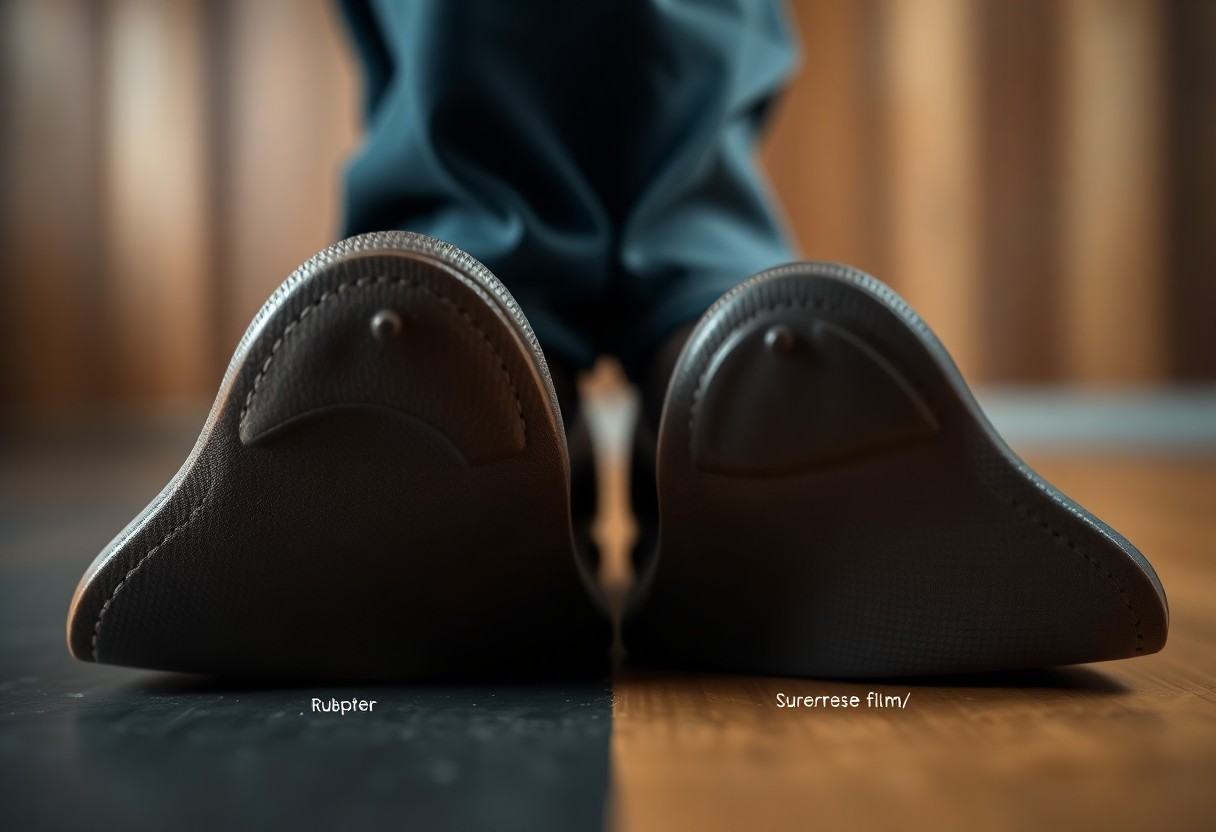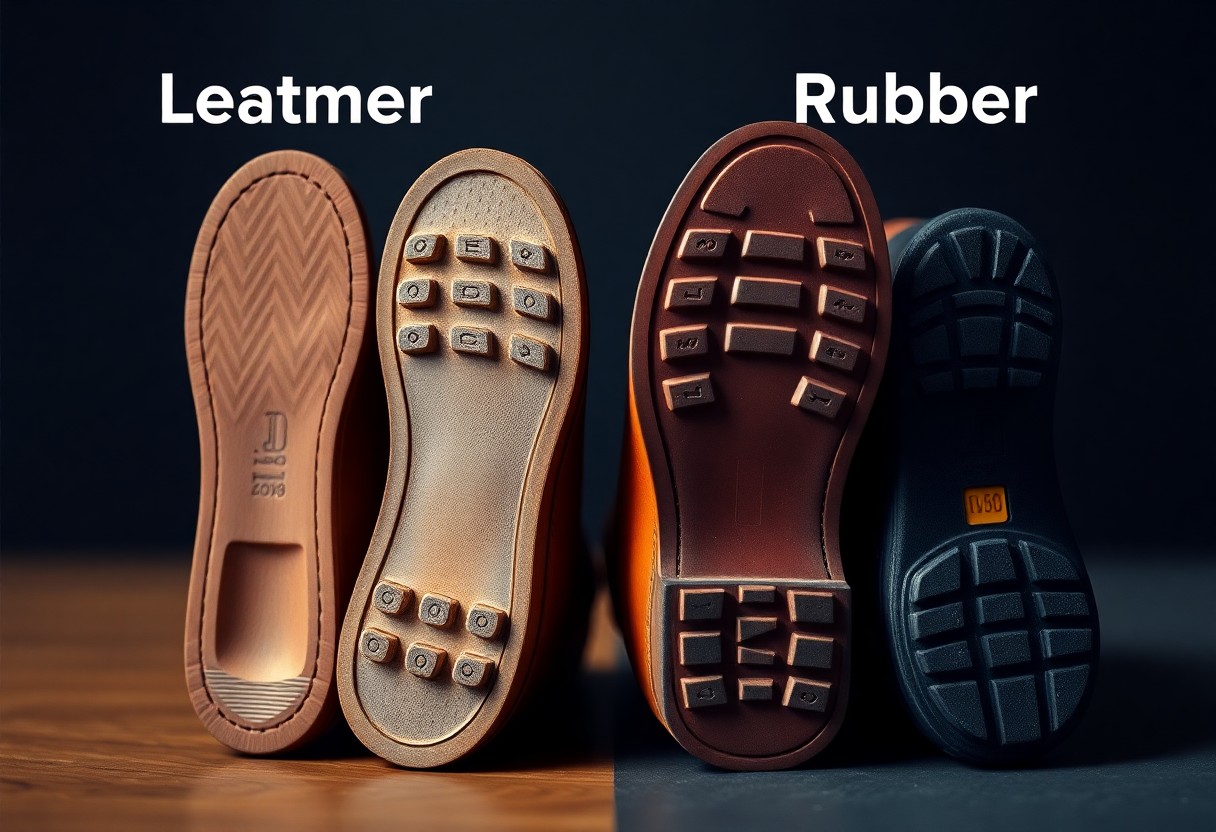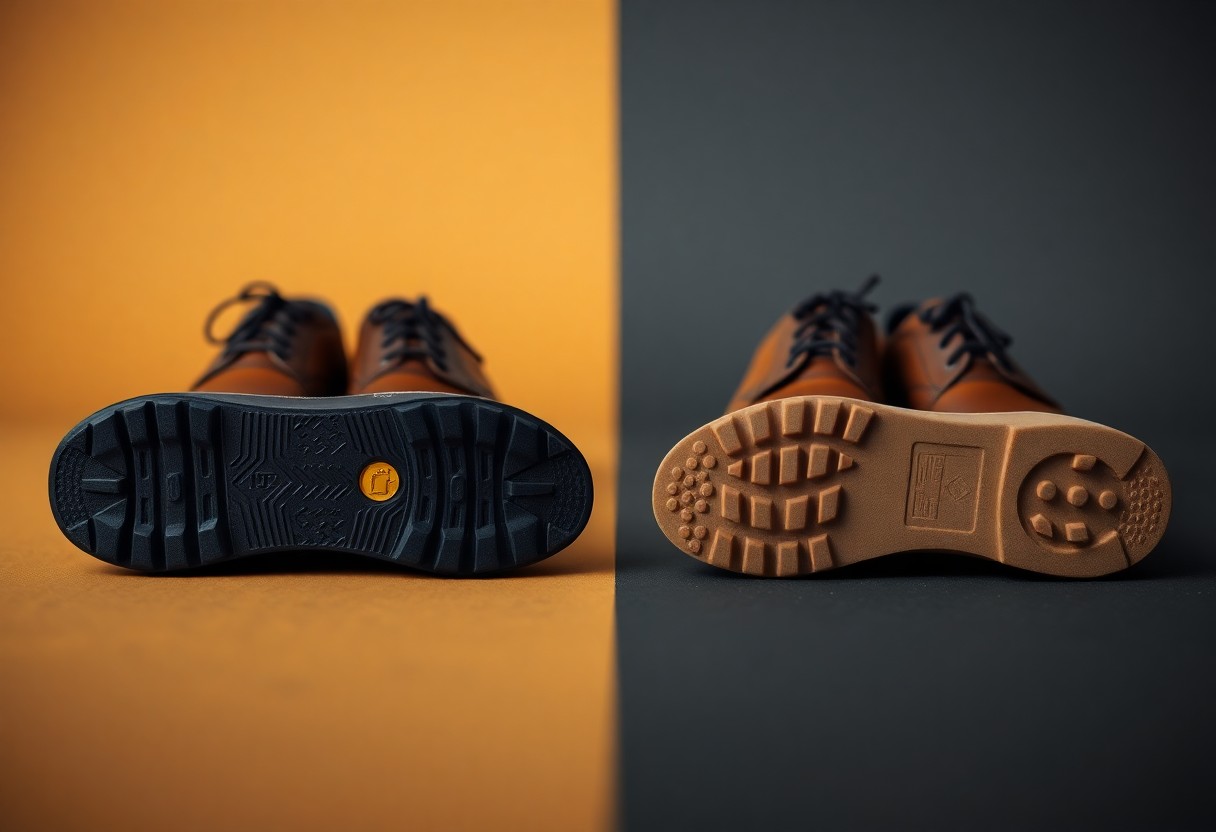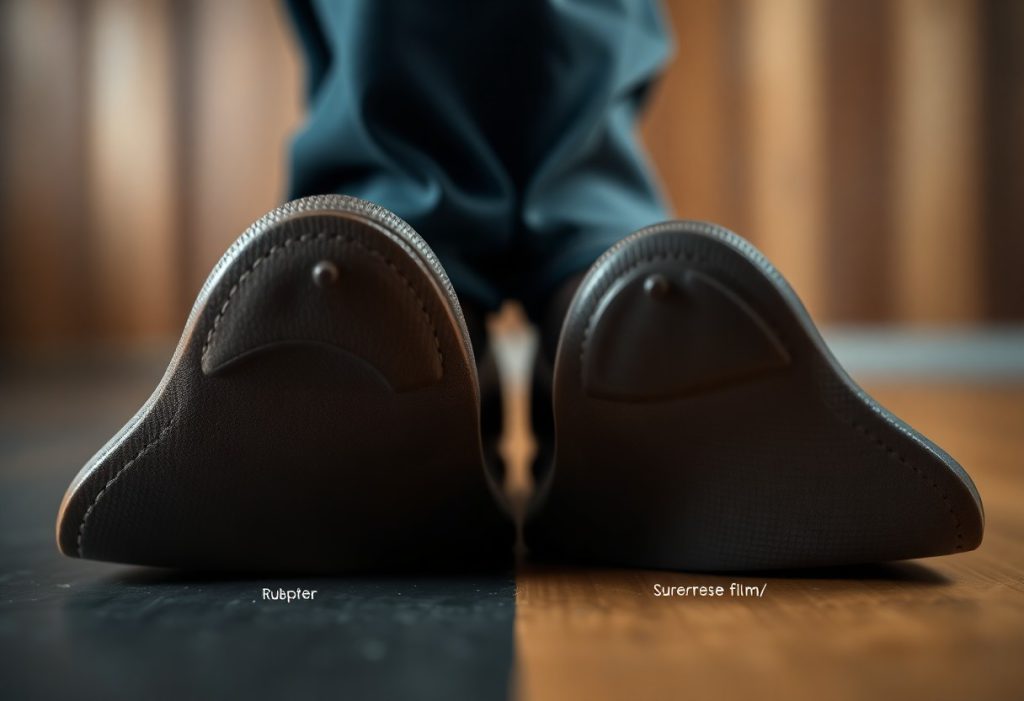When selecting new footwear, buyers often face the important choice between leather and rubber soles. This decision regarding sole material can significantly affect your comfort and overall walking experience. While leather soles offer superior breathability and mold to the unique contours of your feet, rubber soles are celebrated for their outstanding grip and water resistance. Leather soles excel in formal environments and gain character as they age, whereas rubber soles provide immediate comfort and enhanced traction, particularly in wet conditions. This detailed guide aims to delve into the fundamental differences between these materials, empowering you to choose the ideal sole option that suits your specific requirements.

Discovering the Distinct Features of Footwear Sole Materials
Acquiring a comprehensive understanding of the various sole materials available is essential for making informed footwear choices. Each material presents unique benefits and challenges that can have a major impact on your daily comfort, the longevity of your shoes, and your overall satisfaction. The choice between leather and rubber soles will not only affect your walking experience but also play a crucial role in your foot health and the maintenance requirements of your footwear.
Uncovering the Advantages of Leather Soles
For centuries, leather has been regarded as the preferred option for premium footwear. Shoes with leather soles are crafted from natural materials that gradually contour to the shape of your feet, ensuring a customized fit that enhances comfort as time goes by. This material encourages airflow, allowing your feet to breathe and adapt to varying temperature conditions. With proper care, leather soles can endure for 3 to 5 years with regular usage, making them a worthwhile long-term investment.
Understanding the Key Benefits of Rubber Soles
Renowned for their exceptional water resistance and immediate flexibility, rubber soles are a popular choice. Shoes featuring rubber soles provide superior traction on slippery surfaces and offer immediate shock absorption, ensuring comfort right from the moment you slip them on. This material retains its shape and performance across a wide range of weather conditions, positioning rubber soles as an ideal option for everyday use and active lifestyles.
Rubber soles guarantee consistent performance in demanding environments. High-quality rubber soles typically last between 2 to 3 years, requiring minimal upkeep. While rubber provides reliable traction and stability, particularly in wet or slippery circumstances, it generally lacks the breathability found in leather.
Understanding Comfort Factors Associated with Sole Materials
Recognizing how various sole materials influence your daily walking experience is vital for making the right footwear choice. The selection between leather and rubber soles can profoundly affect your foot health and overall comfort. The best sole material should correspond to your walking habits, foot structure, and daily activities to ensure a satisfying fit that meets your lifestyle requirements.
Comfort Attributes of Leather Soles
The comfort offered by leather soles stems from their unique ability to naturally contour and their inherent breathability. Your feet benefit from several features, including:
- Custom contouring that adapts seamlessly to your foot shape
- Natural airflow that helps keep your feet dry and comfortable
- Cork layer cushioning that elevates comfort levels
- Progressive softening with continued wear that enhances fit
By appreciating these attributes, you can make a well-informed decision that prioritizes comfort and foot health over the long term.
Immediate Comfort Provided by Rubber Soles
Rubber soles excel in a variety of weather conditions, delivering instant comfort and shock-absorbing qualities. You will experience immediate flexibility with little to no break-in time, making rubber soles an excellent choice for quick, on-the-go wear.
The advanced technology behind rubber soles ensures outstanding grip and water resistance. While rubber does not conform to your feet like leather, it consistently offers excellent shock absorption and retains its shape, providing vital protection against hard impacts. This makes rubber soles ideal for extensive urban walking, significantly enhancing your comfort in bustling environments.
Comparing Durability Among Sole Materials
When determining whether to choose leather or rubber soles, it is crucial to take into account their distinct wear patterns and overall longevity. Your walking habits and local climate can significantly affect the lifespan of your soles. Both materials have unique strengths regarding durability, but their effectiveness varies widely based on usage and maintenance practices.
The Long-lasting Nature of Leather Soles
With appropriate care and maintenance, leather soles can provide remarkable durability. When safeguarded against excessive moisture and equipped with toe taps, leather-soled shoes can last anywhere from 3 to 5 years with regular use. The quality of leather can be enhanced through multiple layers; for instance, a triple leather sole can outperform many alternatives. However, it is essential to keep them dry and well-maintained to maximize their lifespan.
The Robustness of Rubber Soles
Rubber soles are well-known for their exceptional resistance to water and everyday wear. Your rubber-soled shoes can endure challenging conditions and generally last between 2 to 4 years with regular use. These soles excel on wet surfaces and require significantly less maintenance compared to leather options.
However, it is important to recognize that the durability of rubber soles is dependent on the quality and thickness of the rubber compound used. High-quality rubber compounds can last up to 8 years with proper care, while lower-quality versions may wear out within a few months. Your walking style and frequency of use will ultimately determine the actual lifespan of rubber soles.
Assessing Performance Across Varied Weather Conditions
To make a well-informed decision regarding your footwear, it is essential to understand how different soles perform across various weather conditions. Your choice between leather and rubber soles can significantly impact your comfort and safety in diverse weather situations. Each material presents unique benefits and limitations that affect their performance in wet, dry, or icy conditions.
Leather Soles in Various Weather Conditions
Contrary to popular belief, leather soles may not be the best option for wet environments. Water can cause damage to leather soles, resulting in slippery surfaces. Leather performs best in dry weather, where it provides excellent breathability. In wet conditions, these soles can absorb as much as 80% of their weight in water, leading to accelerated wear and potential damage to your shoes.
Rubber Soles in Diverse Weather Elements
When evaluating the two options, rubber soles offer superior grip and water resistance. You can confidently wear rubber-soled shoes in rain, snow, and on slippery surfaces, benefiting from enhanced traction. These soles maintain their properties in temperatures ranging from -10°C to 40°C, making them versatile for year-round use.
A significant advantage of rubber soles is their exceptional water resistance and resilience in harsh conditions. They keep their shape and grip even after prolonged exposure to moisture. Their non-slip features substantially enhance safety on wet surfaces, reducing your risk of accidents by up to 50% compared to leather soles.

Choosing the Right Style for Your Footwear
In terms of style, not all sole materials are equal. Your choice of sole can dramatically influence the overall appearance of your shoes and their appropriateness for various occasions. While leather soles convey a polished and sophisticated aesthetic, rubber soles offer greater versatility for everyday wear. Your selection should correspond with your lifestyle and the intended use of your footwear.
Classic Elegance of Leather Soles
For formal occasions, leather soles remain the standard choice. They are prominently featured in high-end dress shoes and formal footwear. The sleek profile and natural patina that develops over time enhance their visual charm. Your leather-soled shoes will present a refined edge and maintain an elegant outline, epitomizing classic footwear design.
Contemporary Versatility of Rubber Soles
Nowadays, approximately 70% of modern shoes are designed with rubber soles. Your daily routines often require footwear that can adapt to diverse surfaces and varying weather conditions. Rubber soles offer superior grip and weather resistance, making them ideal for business casual environments and everyday use.
Moreover, it’s worth noting that modern hybrid options combine both materials, providing the best of both worlds. These innovative combinations offer the elegance of leather alongside the functionality of rubber. You can find dress shoes featuring thin rubber inserts or entire rubber soles designed to resemble leather, delivering a balanced solution for your footwear collection.

Understanding the Financial Implications of Sole Materials
Despite the differences in initial pricing, your choice between leather and rubber soles will influence both short-term costs and long-term value. Although leather soles may require more maintenance and occasional resoling, they can last 15 to 20 years with proper care. Rubber soles may provide better upfront value, but they often necessitate complete replacement once they are worn out.
Initial Cost Considerations
Typically, leather-soled shoes command a price that is 20 to 30% higher than their rubber-soled counterparts. Investing in leather soles reflects the cost of high-quality materials and the craftsmanship that goes into their production. This higher initial cost often signifies superior construction techniques, such as Goodyear welting, ensuring both durability and longevity.
Long-term Value of Sole Materials
At first glance, rubber soles may seem more economical, but leather-soled shoes often provide better value over time. With proper care and resoling, leather-soled shoes can last for decades, whereas rubber soles frequently require total replacement once they wear out.
Even though leather soles need regular maintenance and resoling every 2 to 3 years, the costs associated with these services are generally lower than purchasing new shoes. Investing in leather soles pays off over time due to their ability to be repaired and restored, a characteristic that most rubber soles lack once damaged.
Making the Optimal Choice for Your Footwear Requirements
Your decision between leather and rubber soles ultimately depends on your individual needs and lifestyle preferences. Leather soles provide superior moldability and elegance, making them a fantastic choice if you desire footwear that adapts to your feet while exuding a classic appearance. On the other hand, rubber soles offer immediate comfort and exceptional water resistance, making them ideal for those who frequently navigate wet conditions. Your walking habits, local climate, and personal comfort preferences will significantly guide your choice. Both sole types have their rightful place in a well-rounded footwear collection, allowing you to select based on the primary purpose of each pair.
Common Questions About Leather and Rubber Soles
Q: What are the comfort differences between leather and rubber soles?
A: Leather soles gradually adjust to your feet, creating a personalized fit that enhances comfort over time. They perform optimally when paired with cork filling and appropriate arch support. In contrast, rubber soles provide immediate flexibility and superior shock absorption but do not conform to your foot shape. While leather offers improved all-day comfort once broken in, rubber tends to feel comfortable initially but may lead to foot fatigue during prolonged wear.
Q: How do leather and rubber soles compare in durability and weather resistance?
A: Double or triple leather soles with toe taps can last many years with proper care. However, single leather soles wear out more quickly and are prone to water absorption. Rubber soles excel in water resistance and effectively handle rough surfaces. They require less maintenance and perform better in wet conditions. Ultimately, the choice depends on your walking environment and usage frequency.
Q: Which type of sole should I choose based on my specific needs?
A: Opt for leather soles for formal shoes and office wear, especially if your activities take place primarily indoors. They offer enhanced breathability and sophistication. Alternatively, choose rubber soles for daily commuting, frequent outdoor walking, or rainy climates. Consider your walking surface—leather performs well on carpet and smooth floors, while rubber excels on rough pavements and wet surfaces.
The Article Leather soles vs rubber soles key differences benefits and how to choose the right one appeared first on My Shoes Finder
The Article Leather Soles vs Rubber Soles: Key Differences and Benefits Was Found On https://limitsofstrategy.com



This post raises an interesting point about the fundamental differences in sole materials and how they can dramatically influence our walking experience. I’ve often found myself deliberating over the choice between leather and rubber soles when purchasing new shoes. For instance, I recall buying a pair of leather-soled dress shoes for a wedding. While they looked stunning and, over time, beautifully conformed to my feet, I quickly learned their limitations during a rainy evening, which made me appreciate the superior traction and water resistance of rubber soles in contrast.
You’ve touched on a great point about how sole materials can shape our walking experience, and your personal anecdote highlights the nuances of that choice. I can relate to the struggle of choosing between aesthetics and practicality. I remember purchasing a pair of sleek leather boots that I thought would elevate my winter wardrobe. They certainly looked sharp, but the first snowstorm was an eye-opener. The combination of slippery sidewalks and the boots’ lack of grip had me wishing I had opted for something with a rubber sole.
Your exploration of the choice between leather and rubber soles resonates with me deeply, especially as someone who enjoys the nuances of footwear not just for practicality but also for the statement they make. It’s fascinating to consider how these choices reflect individual lifestyles and preferences. I’ve often found myself torn between the elegance of leather and the everyday functionality of rubber, and your analysis brings clarity to this intricate decision-making process.
I completely understand where you’re coming from. The choice between leather and rubber soles really does tap into various aspects of our lives beyond just functionality. It’s almost like footwear becomes a form of self-expression, isn’t it? Personally, I find that both materials have their unique merits depending on the context.